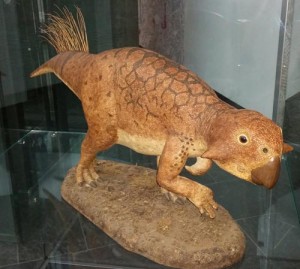New Giant Parrot-Like Species of Dinosaur Discovered (New Species of Psittacosaurus)
New Species of Psittacosaurus Named and Described
Psittacosaurus may not be as well known as later ceratopsians such as Triceratops (horned dinosaurs), but for this genus of dinosaur it has an important place in palaeontology, simply because it is the most species diverse of all the known dinosaur genera.
Psittacosaurus
Now a new species of Psittacosaurus or “parrot lizard” has been named and described – Psittacosaurus gobiensis, making this, in our estimation the ninth type of Psittacosaur to be named and described to date. Once regarded as an ornithopod, psittacosaurs are now believed to be a transitional form between Ornithopoda and the ceratopsians, fossils of these particular dinosaurs are associated with Asia, most famously the Gobi desert region. Although small by dinosaur standards, with the largest species a little over 2 metres long, the numerous fossils found to date have provided scientists with a wealth of data on the evolution and behaviour of these Cretaceous animals.
In recent years some remarkable fossils associated with this genus have been discovered. For example, remains of a group of baby Psittacosaurs were found together, perhaps evidence of herding or flocking behaviour.
To read more about this discovery: Dinosaur Nursery Unearthed in China.
Feathered theropods are known from the fossil record, but another fossil specimen of a Psittacosaurus from Liaoning (China) indicates that these ornithischians may have had feathers too, at least according to a Chinese scientific paper published recently in the journal Nature.
To read about feathered Psittacosaurs: Feathered Ornithopods upset the Scientific Apple Cart.
An Illustration of a Feathered Psittacosaurus
Picture credit: Everything Dinosaur
Psittacosaurus was named “parrot lizard” after its parrot-like beak, this little dinosaur was a low browser, perhaps adapted to feeding on the fruits and nuts of angiosperms (flowering plants). It had long hind legs and was capable of adopting a bipedal stance if required and some fossils indicate that it had long, quills running down its back and along its tail (as illustrated above). Psittacosaurs are associated with Cretaceous strata, P. gobiensis for example, has been dated to approximately 112 million years ago (Aptian faunal stage).
Scientific Paper
In a paper on this new type of dinosaur, P. gobiensis, this one-metre-long dinosaur, may have had a diet dominated by nuts and seeds and this specimen is associated with gastroliths (stomach stones) which may reinforce the high fibre diet theory. The paper on this dinosaur has been published in the Proceedings of the Royal Society B: Biological Sciences.
Picture show the skull of P. gobiensis compared to a the skull of a modern parrot (Macaw). Analysis of the skull of this new psittacosaur indicates that this animal chewed its food in a similar way to parrots.
Professor Paul Sereno, from the University of Chicago commented:
“These and other features, along with the presence of numerous large stomach stones, suggest that psittacosaurs may have had a high-fibre, nut eating diet”.
“Parrot Lizard”
The short snout, just a third of the skull length was different to most dinosaurs, giving the skull its parrot-esque profile.
Professor Sereno went on to add:
“Psittacosaurs are all relatively small in body size, ranging from one to two metres in body length. Their geographic range is limited to central Asia, and their temporal range may be as narrow as 10-20 million years in the mid Cretaceous”.
The head is rather square looking in profile, which along with the heavy beak makes the skull resemble a parrot’s . There are no teeth in the front of the jaw but robust teeth further to the back of the jaws are blunt and designed for chopping and crushing.
To view models of ornithopods, ceratopsians and psittacosaurs visit the models section of the award-winning Everything Dinosaur website: Dinosaur and Prehistoric Animal Models.


